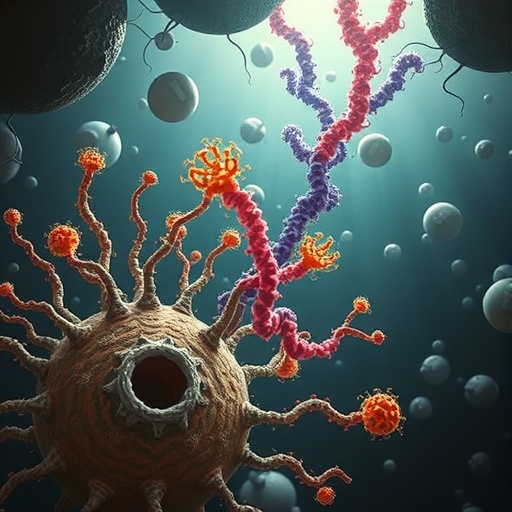In the intricate and densely populated world of microbial communities, the competition for survival is fierce and ongoing, shaping the composition and function of microbiomes across diverse ecosystems. A groundbreaking study published in Nature Microbiology has illuminated the dynamic processes by which bacterial strains displace one another through ecological competition. This revelation not only advances our understanding of microbial ecology but also opens new avenues for manipulating microbiomes in health, agriculture, and environmental management.
The research, conducted by a team led by Bakkeren et al., focuses on the mechanisms underpinning strain displacement within microbiomes—a process where one bacterial strain supplants another in a shared environment. Through a combination of sophisticated in vivo experiments and ecological modeling, the study captures the nuances of bacterial interactions at an unprecedented resolution, revealing how subtle competitive advantages can cascade into major shifts in microbiome structure.
Central to the study is the concept of colonization resistance, a phenomenon where resident microbial populations prevent the establishment of invading strains. Through careful examination of multiple model microbiomes, the researchers demonstrated that strain displacement is not a random event but a deterministic outcome driven by competitive fitness. This fitness encompasses an array of factors including nutrient acquisition strategies, secretion of antimicrobial compounds, and adaptive responses to environmental stressors.
One of the pivotal findings is the identification of specific ecological niches that certain strains exploit more effectively than their competitors. By thriving in these microhabitats, strains gain a foothold that enables them to outcompete others and eventually dominate the microbial landscape. This niche differentiation challenges the previously held notion that microbial communities are solely shaped by broad environmental parameters, emphasizing instead the importance of fine-scale ecological interactions.
Moreover, the study unveils how bacterial strains deploy targeted antagonistic mechanisms like bacteriocin production to inhibit rivals. These molecular weapons provide a direct advantage in competitive encounters, selectively eliminating or suppressing competing strains. The interplay between such antagonistic behaviors and resource competition creates a complex network of interactions that govern community assembly and stability.
The temporal dynamics of strain displacement were also rigorously dissected. The data reveal that displacement events often follow a predictable trajectory, beginning with an early phase where invading strains establish minor populations, followed by a rapid expansion phase where dominance is achieved, and culminating in the exclusion of previously established strains. This progression underscores the non-linear and context-dependent nature of microbial competition.
Integrating empirical observations with ecological modeling, the researchers constructed theoretical frameworks capable of predicting strain displacement under various environmental conditions. These models incorporate key variables such as initial strain abundance, growth rates, and interaction coefficients, enabling simulations that faithfully reproduce observed community shifts. Such predictive power is pivotal for designing interventions intended to steer microbiomes towards desired configurations.
The implications of this work are vast, spanning human health, agriculture, and environmental sustainability. In clinical settings, understanding strain displacement can inform the development of probiotic therapies aimed at displacing pathogenic bacteria with benign or beneficial strains. Similarly, in agriculture, harnessing competitive interactions among microbial strains could enhance soil health and crop productivity by promoting beneficial microbiota.
Additionally, this study offers insights into the resilience of microbiomes in the face of perturbations such as antibiotic treatments, dietary changes, or environmental stressors. By elucidating the mechanisms governing strain dynamics, it becomes possible to predict and potentially mitigate the loss of microbial diversity that often accompanies such disturbances, preserving ecosystem functionality.
An intriguing aspect of the research is its relevance to evolutionary biology. The observed competitive heterogeneity among strains reflects adaptive strategies shaped by evolutionary pressures, highlighting how microbial populations continuously evolve not only to survive but to dominate ecological niches. This evolutionary lens enriches our appreciation of microbiomes as dynamic entities subject to natural selection.
The methodological advances employed by Bakkeren et al. are themselves noteworthy. Using cutting-edge sequencing technologies coupled with advanced computational tools, the team was able to resolve strain-level changes over time with remarkable precision. This technological synergy represents a major step forward in microbiome research, overcoming previous limitations related to population complexity and temporal resolution.
Furthermore, the study carefully addresses the role of horizontal gene transfer in modulating competitive outcomes. By facilitating the acquisition of fitness-enhancing traits, horizontal gene transfer emerges as a critical factor influencing strain coexistence and displacement, adding another layer of complexity to ecological interactions within microbiomes.
The research also touches upon the spatial structure of microbiomes, showing how physical proximity and biofilm formation influence competition. Spatial heterogeneity can create refuges for less competitive strains or conversely, microenvironments where aggressive strains consolidate their dominance. This spatial dimension is crucial for understanding real-world microbiomes, which are rarely homogenous.
Looking ahead, the insights gained from this work pave the way for microbiome engineering—deliberately manipulating strain compositions to achieve health or environmental goals. By leveraging knowledge about ecological competition and strain displacement, scientists could design microbial consortia that are both robust and functional, tailored to specific applications.
In conclusion, Bakkeren et al. have delivered a comprehensive exploration of strain displacement within microbiomes, revealing the intricate balance of competition and cooperation that shapes microbial communities. This study represents a significant leap in microbial ecology, with far-reaching implications that resonate through many fields. As microbiome science continues to evolve, understanding the principles governing strain dynamics will be key to unlocking the full potential of these invisible ecosystems.
Subject of Research: Microbial ecology focusing on strain displacement via ecological competition within microbiomes.
Article Title: Strain displacement in microbiomes via ecological competition.
Article References:
Bakkeren, E., Piskovsky, V., Lee, M.N.Y. et al. Strain displacement in microbiomes via ecological competition. Nat Microbiol (2025). https://doi.org/10.1038/s41564-025-02162-w
Image Credits: AI Generated
DOI: https://doi.org/10.1038/s41564-025-02162-w
Tags: bacterial interactions and fitnesscolonization resistance mechanismscompetitive advantages in microbial ecologyecological competition in microbiomesecological modeling of microbial communitiesenvironmental management of microbiomesimplications for health and agriculturein vivo experiments in microbiologymicrobial strain displacementmicrobiome composition and functionstrategies for manipulating microbiomes





